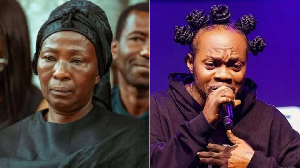Energy think tank Africa Centre for Energy Policy (ACEP) has disagreed with the Power Ministry over explanations into the controversial AMERI power deal.
ACEP in a statement said it is “erroneous” for the government to insist it has not made “any payment to AMERI and will not be making any payments for the cost of the equipment.”
“We know that Government has not made any payment to AMERI. But when VRA makes the monthly payments prescribed by the contract, it will constitute payment for the turbines and the use to which it is being put. Indeed for the entire 5 years, these payments are to be made to AMERI. AMERI will be paid US$850,000 per turbine per month.
“This will amount to US$8.5 million for the ten turbines, with cumulative annual payments of US$102 million. In addition, an amount of US$16.6 million will be paid as variable cost. This brings the total payment due to AMERI and its partners to almost US$120 million,” the ACEP statement said.
Below is the full statement from ACEP
ACEP’S RESPONSE TO THE STATEMENT BY THE MINISTRY OF POWER ON THE AMERI ENERGY POWER PROJECT We wish to commend the Minister of Power for providing clarifications on the AMERI power deal in a press statement following a publication by a Norwegian Newspaper, which also quoted ACEP’s views on the deal. However, the statement provides further questions that need urgent answers.
Under normal circumstances, we would not have responded to the statement because it was not directed at us. However, given that we were the first to raise issues relating to the deal in March 2015; our interest is further strengthened by our quest to ensure an informed public discourse on it. Our response to the statement is therefore articulated as follows.
Ministry of Power: The Ministry wishes to state that the agreement with AMERI is a Build, Own, Operate and Transfer (BOOT) agreement and not an outright purchase of generating plants.
Response: The monthly fees to be paid by VRA for the power produced in the BOOT arrangement inherently includes the leasing or payment charges for the turbines over the five-year period. Indeed since it is the Government that is supplying the fuel through VRA, it stands to reason that all the payments to be made to AMERI consists of the leasing charges as well as O&M costs. So while there is no doubt that it is not an outright purchase (which would have been the best option for Ghana), the cumulative payments to be made over the BOOT period of 5 years constitute the cost of procuring the turbines. What the BOOT arrangement has only done is to spread the payments over a five-year period. The key issue is whether the spreading of payments for a US$220 million project over 5 years end up as US$510 million excluding O&M costs, given that the benchmark cost of capital (Libor) is less than 1%? Is this value for money?
Ministry of Power: The Government of Ghana has not made ANY PAYMENTS to AMERI and will not be making any payments for the cost of the equipment.
Response: This is erroneous. We know that Government has not made any payment to AMERI. But when VRA makes the monthly payments prescribed by the contract, it will constitute payment for the turbines and the use to which it is being put. Indeed for the entire 5 years, these payments are to be made to AMERI. AMERI will be paid US$850,000 per turbine per month. This will amount to US$8.5 million for the ten turbines, with cumulative annual payments of US$102 million. In addition, an amount of US$16.6 million will be paid as variable cost. This brings the total payment due to AMERI and its partners to almost US$120 million.
Ministry of Power: Per the agreement with AMERI, the Government of Ghana through the Volta River Authority (VRA) will only make payments to AMERI for power produced and supplied to the VRA just like any other Independent Power Producer (IPP).
Response: No. This is not a classical IPP arrangement. VRA is paying for the equipment as well and will own it after 5 years. Typical IPP arrangements will not be for 5 years when the equipment can have an operating life of 20 years. As stated earlier, the Government/VRA is supplying fuel so all payments to AMERI will be towards the cost of the turbines plus O&M which is minor compared to the leasing (or Fixed cost) charges.
Ministry of Power: Also, per the agreement, Government was required to provide a standby Letter of Credit (LC) for an amount of US$51 million, which LC has been raised.
Response: This standby LC is to ensure that the monthly payments for the cost of the turbines are secured and in case of default, AMERI will fall on it to redeem any outstanding payment defaults. Note that the LC is revolving so will need to be replaced after being drawn down. Also since fuel supply is on the Government/VRA, the LC is practically a security for payments towards the equipment.
Ministry of Power: Ghana will however assume eventual ownership of the equipment after five (5) years of production and sale of the power to the VRA.
Response: This confirms our point that Ghana is paying for the equipment because it is not possible to take ownership without paying for them assuming as the Ministry said we are only paying for the power produced from the turbines. Indeed, AMERI is not a charity to “donate” 250 MW to Ghana for “free”.
Ministry of Power: It must also be explained that the quoted price of $220 million in the Norwegian story for outright purchase of similar turbines is exclusive of all other costs such as auxiliaries, balance of plant, civil works, sub-station, installation of equipment, cost of financing, operation and maintenance etc.
Response: Ministry of power should confirm the other costs (auxiliaries, balance of plant, financing costs etc) in the case of the AMERI plant. It will certainly not escalate the costs to US$510 million over five years.
Fortunately, METKA, which has a deal with AMERI to technically own, install and operate the turbines for almost five years before handing them over to VRA, stated in a statement that the entire project would cost US$350 million over the period, including the cost of installation, civil works, etc. This sounds reasonable assuming that in addition to the cost of the turbines, about US$130 million would be devoted to meet the other costs (installation, civil works, etc). How did the payments due increase to US$510 million?
We are even worried that Parliament ratified the deal without the benefit of the right information from the Ministry. Government informed Parliament that it would cost Ghana US$411 million if it decided to buy the equipment outright. This departs significantly from the Ministry’s statement, which now put the cost of the equipment at US$220 million (excluding all other costs such as auxiliaries, balance of plant, civil works, sub-station, installation of equipment, cost of financing, operation and maintenance), exactly the figure quoted by ACEP in March 2015. Whether Parliament would have supported the BOOT arrangement if it knew the actual cost of the equipment was US$220 million remains an open question.
Ministry of Power: Under the agreement with AMERI Energy, the cost of all these auxiliary works is being borne by AMERI Energy.
Response: These costs will be recovered through the monthly payments to AMERI, so it should not be made to seem that AMERI is bearing those costs for free. The question is, if Government bought the turbines outright at US$220 million, how much would it have spent to deliver them to Ghana and to install and operate them? Would that have cost US$290 million?
We understand the reason given to Parliament for opting out of an outright purchase was on grounds of lack of money. Assuming this is true, where will Government get the money to pay an annual fee of almost US$120 million to AMERI (US$102 million plus US$16.6 million)? Certainly, this would be raised through tariffs, and why Government failed to justify adjustments in tariffs for the purpose of buying the turbines outright, yet can push for tariff adjustments for non-supply of power over the years, remains poor judgment in our view.
Ministry of Power: From the foregoing, it is false to claim that the Government of Ghana signed a $510 million agreement for the plant, when it should have been $220 million.
Response: The cumulative payments for the plant is US$510 million. So there is no falsehood. If bought outright, it would have been of the order US$220 million subject to any additional costs that the Ministry of Power will provide on the auxiliaries, etc.
Ministry of Power: On claims that the manufacturers of the plant, GE, could have been contacted to negotiate a direct purchase, the Ministry wishes to state that an earlier offer from GE Consortium to the VRA for similar equipment on rental basis proved to be far more expensive and was therefore rejected by the VRA.
Response: The Ministry of Power should furnish the public with the offer made to VRA by GE for transparency sake.
We believe that these responses will contribute to public debate on the AMERI deal. As we have always said; during periods of crises, people in authority resort to crises procurements; and we believe the AMERI deal is no exception. Whilst Ghanaians want more power produced for industrial and domestic use, it is important that we do not compromise value for money and turn round to ask them to pay more for badly negotiated power deals. We encourage the Ministry to in future subject such deals to public debate to ensure that his decisions reflect the genuine concerns and interests of our people.
Singed
Dr. Mohammed Amin Adam Executive Director
General News of Tuesday, 15 December 2015
Source: starrfmonline.com













